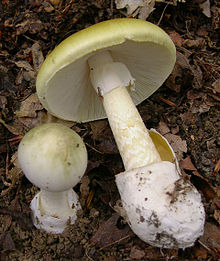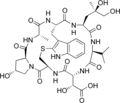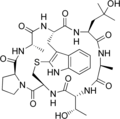Phallotoxin

Phallotoxins addition to the Amatoxinen certain other toxic ingredients types of amanita ( Amanita ) so Amanita phalloides ( A. phalloides ) and the white death cap mushrooms Spring ( A. verna ) and Amanita virosa ( A. virosa ).
In the case of tuber agaric poisoning, the phallotoxins, which are built up as bicyclic heptapeptides from seven ring-shaped amino acids , play a lesser role than the related octapeptides of the amatoxins, because they are not absorbed through the intestine like these. If they do get into the bloodstream, their effect is quicker and also highly toxic.
The phallotoxins belong to the cytoskeleton inhibitors and block its remodeling. Their properties as stabilizers for actin filaments are used in molecular biology in order to be able to better represent elements of the cell skeleton . Phallotoxins are mostly amorphous , water-soluble solids. To date, seven naturally occurring ones are known, all of which have the same basic structure: in addition to phalloidin, also phalloin, phallisin, phallacin, phallicidin, phallisacin and prophalloin .
history
As one of the toxins of the green death cap mushroom ( Amanita phalloides ) was the chief representative of phallotoxins that phalloidin , for the first time in 1936 by Feodor Lynen shown and Ulrich Wieland crystalline, the Chemical Institute of the University of Munich under the direction of Heinrich Wieland . Theodor Wieland studied the structure of this peptide in more detail from the 1950s. It was the first cyclic peptide to be discovered . The helical conformation of its special structural element, a thioether bridge over an S atom, could only be clarified late; this makes it a bicyclic peptide with exceptional rigidity and high stability.
features
All naturally occurring phallotoxins are cyclopeptides made up of seven amino acids , two of which are connected as tryptathionine via an additional sulfide cross bridge, so that a bicyclic heptapeptide is present. The amatoxins , made up of eight amino acids, have similar structural features , where the Trp - Cys cross bridge is designed as a sulfoxide .
In contrast to these octapeptides, the phallotoxins are almost ineffective when taken orally , as they are not absorbed by the healthy intestine. However, if they get into the bloodstream - through mucosal wounds or by injection - they quickly develop their toxicity, especially in cells of the liver , and can be fatal within a few hours. The lethal dose LD 50 ( mouse i.p. ) is 2 to 3 mg / kg for the main representative phalloidin. All phallotoxins have the same basic structure in common, the individual representatives differ from one another in the residues of side chains.
Representative
| Surname | R 1 | R 2 | R 3 | R 4 |
|---|---|---|---|---|
| Phallacin | CH 2 C (OH) (CH 3 ) 2 | CH (CH 3 ) 2 | CH (OH) COOH | OH |
| Phallacidin | CH 2 C (OH) (CH 3 ) CH 2 OH | CH (CH 3 ) 2 | CH (OH) COOH | OH |
| Phallisacin | CH 2 C (OH) (CH 2 OH) 2 | CH (CH 3 ) 2 | CH (OH) COOH | OH |
| Phallisin | CH 2 C (OH) (CH 2 OH) 2 | CH 3 | CH (OH) CH 3 | OH |
| Phalloidin | CH 2 C (OH) (CH 3 ) CH 2 OH | CH 3 | CH (OH) CH 3 | OH |
| Phalloin | CH 2 C (OH) (CH 3 ) 2 | CH 3 | CH (OH) CH 3 | OH |
| Prophalloin | CH 2 C (OH) (CH 3 ) 2 | CH 3 | CH (OH) CH 3 | H |
Occurrence
Phalloidin, along with other phallotoxins and amatoxins, was found in various types of death cap mushrooms . The Kegelhütige Knollenblätterpilz ( Amanita virosa ) also contains Virotoxine , the Phallotoxinen similar monocyclic heptapeptides, which lack an internal cross-bridge. The yellow cap mushroom ( Amanita citrina ), on the other hand, which also occurs as a white variant, only contains bufotenin .
Mode of action
The main active principle is an inhibition of the restructuring of the cytoskeleton (necessary for cell movements). Phallotoxins bind irreversibly to polymerized actin - the F-actin that actin filaments consist of - and thus hinder the breakdown and remodeling of these filamentous structures.
The high affinity for the F-actin of the microfilaments is used in specific molecular biological staining techniques to make parts of the cytoskeleton visible.
See also
In contrast to the phallotoxins, which hinder the depolymerization of F-actin, the latrunculins - special toxins from marine sponges and snails - act as cytoskeleton inhibitors by disrupting the polymerization of G-actin into microfilaments .
literature
- Entry on phallotoxins. In: Römpp Online . Georg Thieme Verlag, accessed on January 2, 2015.
- Theodor Wieland : Amatoxine, Phallotoxine - the poisons of the leaf mushroom, chemistry in our time, 13th year 1979, No. 2, pp. 56-63, ISSN 0009-2851
Individual evidence
- ↑ Theodor Wieland: Modern natural product chemistry using the example of the fungal poison phalloidin, presented at the meeting on April 25, 1981 . Springer-Verlag, 2013, ISBN 978-3-642-46451-5 , p. 22 ( limited preview in Google Book search).
- ↑ Bernd Gutte: Peptides Synthesis, Structures, and Applications . Academic Press, 1995, ISBN 978-0-08-053859-4 , pp. 33 ( limited preview in Google Book search).








